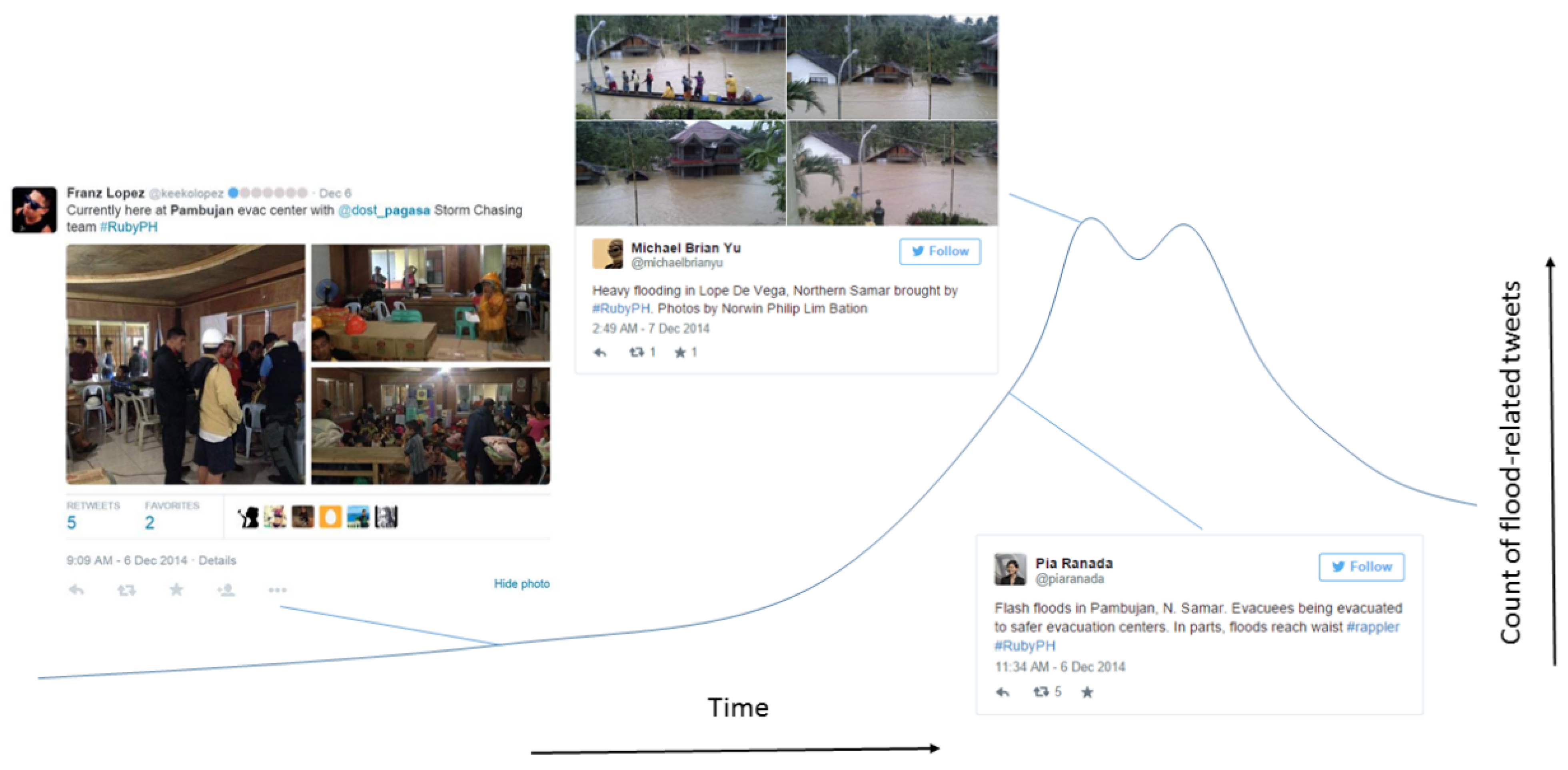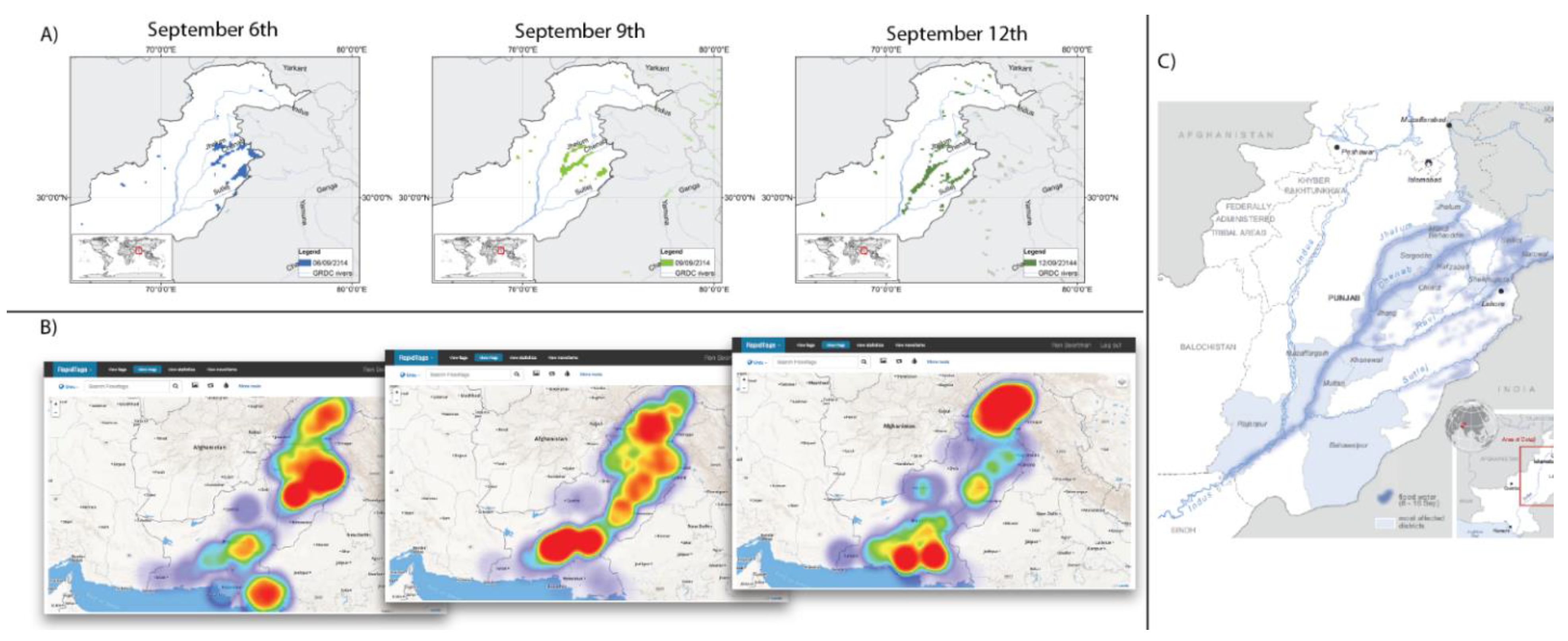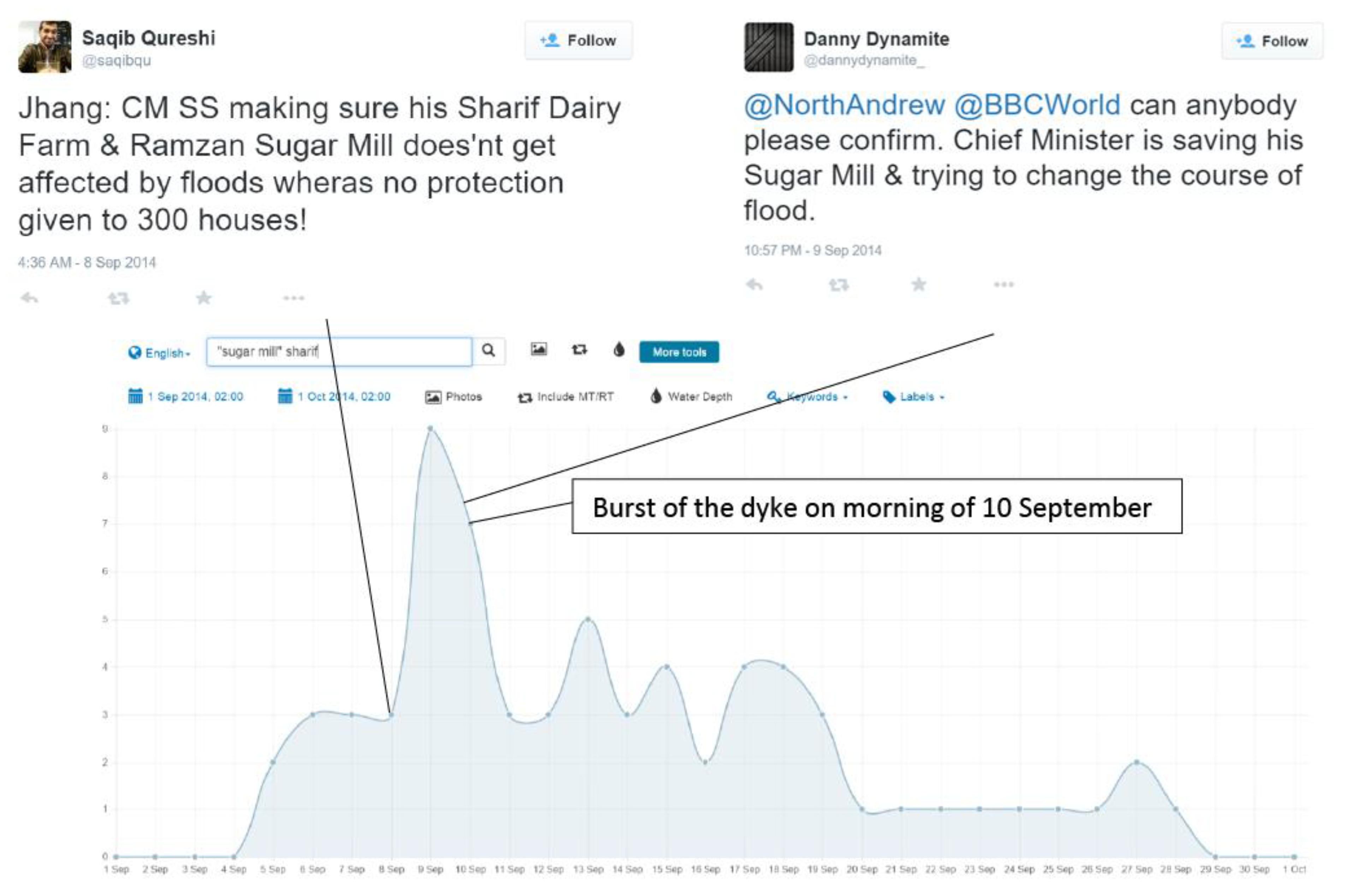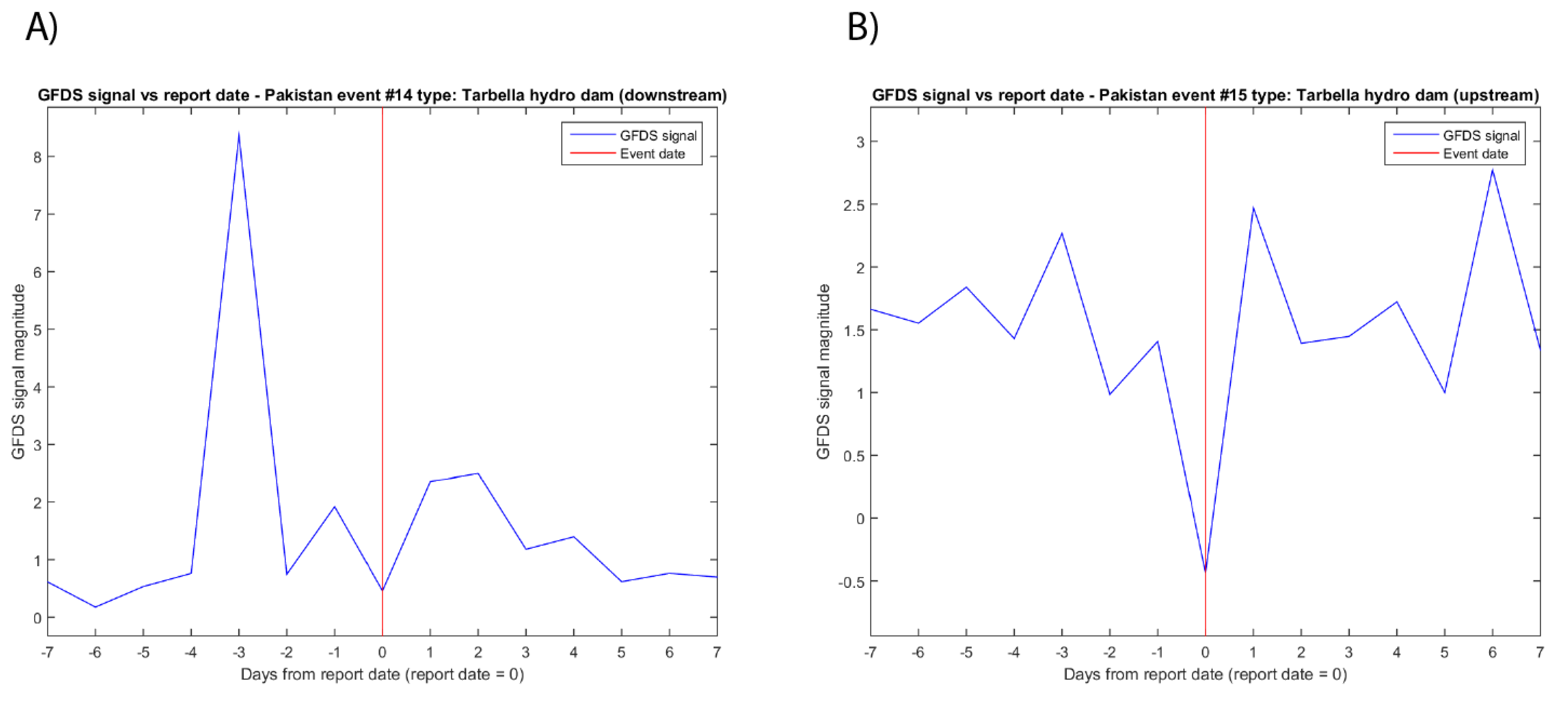Early Flood Detection for Rapid Humanitarian Response: Harnessing Near Real-Time Satellite and Twitter Signals
Abstract
:1. Introduction
- (1)
- Where is the flood?
- (2)
- When can we know about the flooding?
- (3)
- What do we know about the impacts?
2. Methods and Data
2.1. Disaster Reporting and Response Information
| WHAT Kind of Flood (Floods, Flash Floods, and Flooding Caused by the Opening or Failure of Dams) | WHERE did the Event Happen (Village/Region) | WHEN did the Event Happen? | WHEN Was the Event Reported/Known to the PRC (and by What Media, if Possible)? | WHEN Was Action Undertaken by PRC in Response to the Event? | Event Type |
|---|---|---|---|---|---|
| Overflowing of rivers due to TD Lingling (Local name: Agaton) | Compostela Valley | 11/1/2014 | 11/1/2014 (Online news and local PRC Chapter report) | 11/1/2014—Deployed volunteer for assessment 13/1/2014—Served Hot meals to 530 persons | Tropical Depression |
| Overflowing of river due to Typhoon Rammasun (Local name: Glenda) | Northern Samar | 15/7/2014 | 15/7/2014 (Chapter Report/Volunteers on the ground) | Alerted volunteers to the area and mobilised 35 volunteers and staff. 16/7/2015—Served hot meals to 620 individuals, Distributed Non Food Items to 202 Families, and Food Items to 788 Families. | Typhoon |
2.2. Near-Real-Time Satellite Data
2.3. Near-Real-Time Twitter Data
| Language | Flood Tweets Containing Pakistan Places (September 2014; One Event) | Flood Tweets Containing Philippine Places (July 2014–January 2015; Multiple Events) |
|---|---|---|
| English | 197,651 | 458,689 |
| Urdu | 74,141 | 0 |
| Filipino | 0 | 36,055 |
2.4. Analytics and Outputs
2.4.1. Location mapping
2.4.2. Early detection

2.4.3. Event understanding
3. Results and Discussion
3.1. Rapid Flood Mapping

3.2. Rapid Flood Detection


3.3. Improving Event Understanding



4. Conclusions and Recommendations
4.1. GFDS satellite information
4.2. Twitter Analysis
4.3. Recommendations for further research
- -
- Post-processing and filtering: further research efforts are needed to develop comprehensive near-real-time post-processing and filtering methodologies for social media content. These methodologies, which may include more sophisticated textual, geographical, and sentimental analyses, should aim for improving the accuracy of the location and impact analytics that are derived from this data, making the information more useful for humanitarian organizations.
- -
- Near-real-time action trigger analysis: this study has shown that many of the flood events can be traced in the GFDS and Twitter signal, as a relative increase in signal compared to the baseline. However, there is currently no link between a certain signal magnitude and the probability or intensity of a flood and, therefore, with certain preparedness or response measures. Further research efforts are needed to analyze the signal magnitude during floods in various geographical settings, to link these magnitudes to relevant preparedness measures at the side of humanitarian organizations, and to establish the communication links between the data producers and humanitarian organizations to enable these actions to be taken.
- -
- Linking signals with vulnerabilities: humanitarian organizations such as the PRC are conducting regular Vulnerability Capacity Assessments (VCAs) in order to understand the vulnerability of communities [51]. There is a potential for linking the flood signals from satellite observation and social media to detailed knowledge of the vulnerabilities in the area, to make a more substantiated judgment about potential humanitarian actions in the region.
- -
- Citizen reporters: there are currently initiatives ongoing in the Philippines to deploy “citizen reporters”, which are civilians who are asked for real-time information of ongoing events which is then used publicly by TV news stations. The system of citizen reporters may be equally valuable for humanitarian organizations, who could follow and support their volunteers during ongoing events, using social media such as Twitter. Research is needed to assess how such an approach could be implemented in the work flow of humanitarian organizations, and how this could be used to improve disaster response.
- -
- Partnerships: Easy access to information generated by social media, and using it accordingly, can be a way forward towards new partnerships in disaster preparedness and response, and towards evolving approaches of working together. Research is needed to establish which partners are currently involved in disaster reduction and response, and how harnessing social media could change their relationships.
Acknowledgments
Author Contributions
Conflicts of Interest
References
- Munich Re. NatCatSERVICE Database; Munich Reinsurance Company Geo Risks Research: Munich, Germany, 2014. [Google Scholar]
- Jongman, B.; Winsemius, H.C.; Aerts, J.C.J.H.; Coughlan de Perez, E.; van Aalst, M.K.; Kron, W.; Ward, P.J. Declining vulnerability to river floods and the global benefits of adaptation. Proc. Natl. Acad. Sci. USA 2015, 112. [Google Scholar] [CrossRef] [PubMed]
- The United Nations Office for Disaster Risk Reduction (UNISDR). Global Assessment Report on disaster risk reduction 2015: Making Development Sustainable: The Future of Disaster Risk Management; The United Nations Office for Disaster Risk Reduction: Geneva, Switzerland, 2015. [Google Scholar]
- International Federation of Red Cross and Red Crescent Societies (IFRC). Emergency Appeal: Malawi Floods 2015; International Federation of Red Cross and Red Crescent Societies (IFRC): Geneva, Switzerland, 2015. [Google Scholar]
- Kellett, J.; Caravani, A. Financing Disaster Risk Reduction: A 20 Year Story of International Aid; Global Facility for Disaster Reduction and Recovery (GFDRR): Washington, DC, USA, 2013. [Google Scholar]
- Coughlan de Perez, E.; Monasso, F.; van Aalst, M.; Suarez, P. Science to prevent disasters. Nat. Geosci. 2014, 7, 78–79. [Google Scholar] [CrossRef]
- Zhang, D.; Zhou, L.; Nunamaker, J.F., Jr. A knowledge management framework for the support of decision making in humanitarian assistance/disaster relief. Knowl. Inf. Syst. 2002, 4, 370–385. [Google Scholar] [CrossRef]
- Asplund, M.; Nadjm-Tehrani, S.; Sigholm, J. Emerging information infrastructures: Cooperation in disasters. In Critical Information Infrastructure Security; Setola, R., Geretshuber, S., Eds.; Springer: Berlin, Germany, 2009; pp. 258–270. [Google Scholar]
- Meier, P. Digital Humanitarians: How Big Data Is Changing the Face of Humanitarian Response; Taylor and Francis Press: Abingdon, UK, 2015. [Google Scholar]
- NASA NRT. Global Flood Mapping. Available online: http://oas.gsfc.nasa.gov/floodmap/ (accessed on 13 Junuary 2015).
- Brakenridge, R.; Anderson, E. MODIS-based flood detection, mapping and measurement: The potential for operational hydrological applications. In Transboundary Floods: Reducing Risks Through Flood Management; Marsalek, J., Stancalie, G., Balint, G., Eds.; Springer: Rotterdam, The Netherlands, 2006; pp. 1–12. [Google Scholar]
- De Groeve, T.; Riva, P. Global real-time detection of major floods using passive microwave remote sensing. In Proceedings of the 33rd International Symposium on Remote Sensing of Environment, Stresa, Italy, 4–8 May 2009.
- Memon, A.A.; Muhammad, S.; Rahman, S.; Haq, M. Flood monitoring and damage assessment using water indices: A case study of Pakistan flood-2012. Egypt. J. Remote Sens. Sp. Sci. 2015, 18, 99–106. [Google Scholar] [CrossRef]
- European Commission Humanitarian Aid & Civil Protection ERCC Portal. Available online: http://erccportal.jrc.ec.europa.eu/Maps/Daily-maps# (accessed on 18 August 2015).
- Ao, J.; Zhang, P.; Cao, Y. Estimating the locations of emergency events from Twitter streams. Procedia Comput. Sci. 2014, 31, 731–739. [Google Scholar] [CrossRef]
- Abdelhaq, H.; Gertz, M. On the locality of keywords in Twitter streams. In Proceedings of the 5th ACM SIGSPATIAL International Workshop on GeoStreaming, Dallas, TX, USA, 4 November 2014.
- Leetaru, K.H.; Perkins, T.K.; Rewerts, C. Fulltext geocoding versus spatial metadata for large text archives: Towards a geographically enriched wikipedia. D-Lib Mag. 2012, 18. [Google Scholar] [CrossRef]
- Muralidharan, S.; Rasmussen, L.; Patterson, D.; Shin, J.H. Hope for Haiti: An analysis of Facebook and Twitter usage during the earthquake relief efforts. Public Relat. Rev. 2011, 37, 175–177. [Google Scholar] [CrossRef]
- Goodchild, M.F.; Glennon, J.A. Crowdsourcing geographic information for disaster response: A research frontier. Int. J. Digit. Earth 2010, 3, 231–241. [Google Scholar] [CrossRef]
- Earle, P.; Guy, M.; Buckmaster, R.; Ostrum, C.; Horvath, S.; Vaughan, A. OMG earthquake! Can Twitter improve earthquake response? Seismol. Res. Lett. 2010, 81, 246–251. [Google Scholar] [CrossRef]
- Vieweg, S.; Hughes, A.L.; Starbird, K.; Palen, L. Microblogging during two natural hazards events: What Twitter may contribute to situational awareness. In Proceedings of the 2010 ACM Conference on Human Factors in Computing Systems, Atlanta, GA, USA, 10–15 April 2010.
- Muller, C.L.; Chapman, L.; Johnston, S.; Kidd, C.; Illingworth, S.; Foody, G.; Overeem, A.; Leigh, R.R. Crowdsourcing for climate and atmospheric sciences: Current status and future potential. Int. J. Climatol. 2015, 35, 3185–3203. [Google Scholar] [CrossRef]
- Muller, C.L. Mapping snow depth across the West Midlands using social media-generated data. Weather 2013, 68, 82. [Google Scholar] [CrossRef]
- Takahashi, B.; Tandoc, E.C.; Carmichael, C. Communicating on Twitter during a disaster: An analysis of Tweets during Typhoon Haiyan in the Philippines. Comput. Hum. Behav. 2015, 50, 392–398. [Google Scholar] [CrossRef]
- Neubaum, G.; Rösner, L.; Rosenthal-von der Pütten, A.M.; Krämer, N.C. Psychosocial functions of social media usage in a disaster situation: A multi-methodological approach. Comput. Hum. Behav. 2014, 34, 28–38. [Google Scholar] [CrossRef]
- Monsoon Weather Situation Report 2014; North Dakota Medical Association (NDMA): Islamabad, Pakistan, 2014.
- Pakistan Floods 2014: Recovery Needs Assessment and Action Framework 2014–2016. Available online: http://www.ndma.gov.pk/new/Documents/Recovery_Needs_Assessment.pdf (accessed on 26 June 2015).
- Wu, H.; Adler, R.F.; Tian, Y.; Huffman, G.J.; Li, H.; Wang, J. Real-time global flood estimation using satellite-based precipitation and a coupled land surface and routing model. Water Resour. Res. 2014, 50, 2693–2717. [Google Scholar] [CrossRef]
- FloodTags. Available online: https://www.floodtags.com/ (accessed on 8 September 2015).
- Hahmann, S.; Purves, R.; Burghardt, D. Twitter location (sometimes) matters: Exploring the relationship between georeferenced tweet content and nearby feature classes. J. Spat. Inf. Sci. 2014, 2014, 1–36. [Google Scholar] [CrossRef]
- Leetaru, K.; Wang, S.; Cao, G.; Padmanabhan, A.; Shook, E. Mapping the global Twitter heartbeat: The geography of Twitter. First Monday 2013, 18. [Google Scholar] [CrossRef]
- 30 m Internet Users in Pakistan, Half on Mobile: Report. Available online: http://tribune.com.pk/story/567649/30m-internet-users-in-pakistan-half-on-mobile-report/ (accessed on 21 May 2015).
- Guan, X.; Chen, C. Using social media data to understand and assess disasters. Nat. Hazards 2014, 74, 837–850. [Google Scholar] [CrossRef]
- Gove, R.; Gramsky, N.; Kirby, R.; Sefer, E.; Sopan, A.; Dunne, C.; Shneiderman, B.; Taieb-Maimon, M. NetVisia: Heat map & matrix visualization of dynamic social network statistics & content. In Proceedings of the 2011 IEEE Third International Conference on Privacy, Security, Risk and Trust and 2011 IEEE Third International Conference on Social Computing (SocialCom), Boston, MA, USA, 9–11 October 2011; pp. 19–26.
- Schreck, T.; Keim, D. Visual analysis of social media data. Computer 2013, 46, 68–75. [Google Scholar] [CrossRef]
- UN Office for the Coordination of Humanitarian Affairs. Pakistan: Humanitarian Snapshot—Floods (as of 2 Oct 2014); UN Office for the Coordination of Humanitarian Affairs: Geneva, Switzerland, 2014. [Google Scholar]
- Brakenridge, G.R.; Kettner, A.; Syvitski, J.; Overeem, R.; de Groeve, T.; Cohen, S.; Nghiem, S.V. River Watch 2. Satellite River Discharge and Runoff Measurements: Technical Summary; University of Colorado: Boulder, CO, USA.
- European Commission Joint Research Centre. Global Flood Detection System: Flood status report for Bangladesh. Available online: http://www.gdacs.org/flooddetection/monitoringregion.aspx?filter=Bangladesh (accessed on 14 September 2015).
- Ward, P.J.; Jongman, B.; Salamon, P.; Simpson, A.; Bates, P.; de Groeve, T.; Muis, S.; de Perez, E.C.; Rudari, R.; Trigg, M.A.; et al. Usefulness and limitations of global flood risk models. Nat. Clim. Chang. 2015, 5, 712–715. [Google Scholar] [CrossRef]
- Alfieri, L.; Burek, P.; Dutra, E.; Krzeminski, B.; Muraro, D.; Thielen, J.; Pappenberger, F. GloFAS-global ensemble streamflow forecasting and flood early warning. Hydrol. Earth Syst. Sci. 2013, 17, 1161–1175. [Google Scholar] [CrossRef] [Green Version]
- Coughlan de Perez, E.; van den Hurk, B.; van Aalst, M.K.; Jongman, B.; Klose, T.; Suarez, P. Forecast-based financing: An approach for catalyzing humanitarian action based on extreme weather and climate forecasts. Nat. Hazards Earth Syst. Sci. 2015, 15, 895–904. [Google Scholar] [CrossRef]
- Revilla-Romero, B.; Hirpa, F.A.; Thielen, J.; Salamon, P.; Brakenridge, G.R.; Pappenberger, F.; de Groeve, T. Evaluation of global flood forecasting and satellite monitoring systems in data-sparse regions—A challenge. Remote Sens 2015. under review. [Google Scholar]
- Di Baldassarre, G.; Schumann, G.; Bates, P.D. A technique for the calibration of hydraulic models using uncertain satellite observations of flood extent. J. Hydrol. 2009, 367, 276–282. [Google Scholar] [CrossRef]
- Milzow, C.; Krogh, P.E.; Bauer-Gottwein, P. Combining satellite radar altimetry, SAR surface soil moisture and GRACE total storage changes for hydrological model calibration in a large poorly gauged catchment. Hydrol. Earth Syst. Sci. 2011, 15, 1729–1743. [Google Scholar] [CrossRef]
- Zhang, Y.; Hong, Y.; Wang, X.; Gourley, J.J.; Gao, J.; Vergara, H.J.; Yong, B. Assimilation of passive microwave streamflow signals for improving flood forecasting: A first study in Cubango River Basin, Africa. IEEE J. Sel. Top. Appl. Earth Obs. Remote Sens. 2013, 6, 2375–2390. [Google Scholar] [CrossRef]
- Giustarini, L.; Matgen, P.; Hostache, R.; Montanari, M.; Plaza, D.; Pauwels, V.R. N.; de Lannoy, G.J. M.; de Keyser, R.; Pfister, L.; Hoffmann, L.; et al. Assimilating SAR-derived water level data into a hydraulic model: A case study. Hydrol. Earth Syst. Sci. 2011, 15, 2349–2365. [Google Scholar] [CrossRef] [Green Version]
- Van Laere, O.; Schockaert, S.; Dhoedt, B. Georeferencing Flickr resources based on textual meta-data. Inf. Sci. 2013, 238, 52–74. [Google Scholar] [CrossRef] [Green Version]
- Dunkel, A. Visualizing the perceived environment using crowdsourced photo geodata. Landsc. Urban. Plan. 2015, 142, 173–186. [Google Scholar] [CrossRef]
- Hürriyetoğlu, A. Tweet stream analysis for flood time estimation. In Proceedings of the 25th Meeting of Computational Linguistics in the Netherlands, Antwerp, Belgium, 5–6 February 2015.
- Galton, F. Vox Populi (The wisdom of the crowds). Nature 1949, 75, 450–451. [Google Scholar] [CrossRef]
- Van Aalst, M.K.; Cannon, T.; Burton, I. Community level adaptation to climate change: The potential role of participatory community risk assessment. Glob. Environ. Chang. 2008, 18, 165–179. [Google Scholar] [CrossRef]
© 2015 by the authors; licensee MDPI, Basel, Switzerland. This article is an open access article distributed under the terms and conditions of the Creative Commons Attribution license (http://creativecommons.org/licenses/by/4.0/).
Share and Cite
Jongman, B.; Wagemaker, J.; Romero, B.R.; De Perez, E.C. Early Flood Detection for Rapid Humanitarian Response: Harnessing Near Real-Time Satellite and Twitter Signals. ISPRS Int. J. Geo-Inf. 2015, 4, 2246-2266. https://0-doi-org.brum.beds.ac.uk/10.3390/ijgi4042246
Jongman B, Wagemaker J, Romero BR, De Perez EC. Early Flood Detection for Rapid Humanitarian Response: Harnessing Near Real-Time Satellite and Twitter Signals. ISPRS International Journal of Geo-Information. 2015; 4(4):2246-2266. https://0-doi-org.brum.beds.ac.uk/10.3390/ijgi4042246
Chicago/Turabian StyleJongman, Brenden, Jurjen Wagemaker, Beatriz Revilla Romero, and Erin Coughlan De Perez. 2015. "Early Flood Detection for Rapid Humanitarian Response: Harnessing Near Real-Time Satellite and Twitter Signals" ISPRS International Journal of Geo-Information 4, no. 4: 2246-2266. https://0-doi-org.brum.beds.ac.uk/10.3390/ijgi4042246






